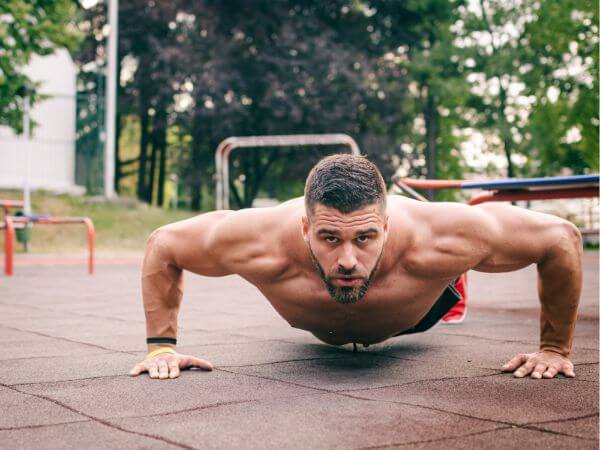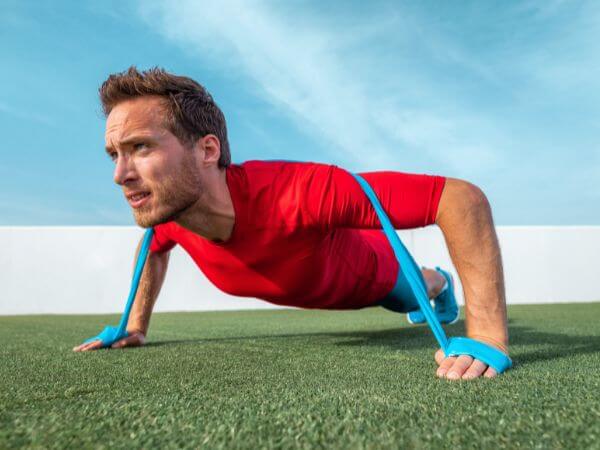One of the most common exercises people use to work their arms is the push-up. But does this exercise actually work the biceps muscles?
The answer may surprise you.
This blog post will look at the science behind the push-up and determine if it is an effective way to work your biceps muscles.
Table of Contents
How Push-Ups Work
The push-up is a compound exercise, meaning that it works multiple muscle groups at the same time. The primary muscles worked during a push-up are the pectoralis major (chest) and triceps brachii (back of the arm).
However, the biceps brachii (front of the arm) also gets activated during a push-up.
So, does this mean that the push-up is an effective exercise for working the biceps? The short answer is yes. The long answer is a bit more complicated.
The Long Answer
The biceps brachii is a two-headed muscle with two points of origin on the shoulder blade. The long head is activated more during exercises involving overhead movement (like the military press). In contrast, the other head (the short head) is activated more during exercises that involve chest movement (like the bench press).
Enter the push-up.
This exercise primarily involves chest movement, which means that the short head of the biceps brachii is activated more than the long head. However, both heads of the muscle are still activated to some degree during a push-up.
What does that mean?
If you want to focus on working your biceps with the push-up, you should aim for a higher number of reps (15-20) and focus on using a slow and controlled tempo.
Otherwise, a traditional push-up will only tone your biceps; it won’t build more lean muscles there.
Here’s how you can get better results:
Push-Up Variations for Better Biceps Engagement

The traditional push-up position has your arms shoulder-width apart or slightly wider, with your shoulders, elbows, and wrists aligned.
But that doesn’t build your biceps as much as you would want.
Here’s what gets you better results:
Close-Stance Push-Up
Get into the traditional push-up position, but move your hands closer together so they are about six inches apart. This position will force your biceps to work harder to stabilize your body.
Reverse-Hand Push-Up
This push-up variation appears online under “bicep push-up” because it activates your biceps the most. Here’s how it works:
- Get into the traditional push-up position, but place your hands with your fingertips facing your feet.
- Bend your elbows to bring your chest as close to the ground as possible.
- Lift your chest up again.
So, each time you bend your elbows to lower your upper body closer to the ground, you will do a bodyweight bicep curl.
Pro tip: Start from your knees to ensure you can hold a proper form first. Also, warm up properly before attempting it.
Single-Arm Push-Up
This push-up variation can efficiently work on your unilateral (single-side) strength and stability. Here’s how it works:
- Get into the traditional push-up position, but place your right hand behind your back.
- Lower yourself with your left arm.
- Press back up to the starting position.
- Repeat the exercise with your right arm.
Doing this exercise with just one arm forces your core muscles to work harder to keep your body stable, and it also challenges your biceps more than a traditional push-up.
Tips to Maximise Bicep Results

Now that you know which push-up variations work the biceps the best, here are a few tips to help you get the most out of your workouts:
- To build bigger biceps, you need to lift heavier weights. In this case, you can consider donning a weighted vest.
- Remember to focus on using a slow and controlled tempo. This pace will help you maximize muscle growth.
- Wear a resistance band on your arms, a bit above your elbows. That strategy helps you get lower to the ground and get more tone out of your muscles in the process.
Last but not least, make sure to warm up properly before each workout. Warming up helps you avoid injuries and maximize your workouts.
Wrap Up
Push-ups are a great way to work your biceps, but they are only one piece of the puzzle. To build bigger and stronger biceps, you need to include a variety of exercises in your workouts.
In addition to push-ups, you can also try incorporating some of these exercises into your routine:
- Bicep curls
- Triceps dips
- Chin-ups
- Hammer curls
- Barbell curls
- EZ-bar curls
- Dumbbell curls
Be consistent with your workouts and focus on using a slow and controlled tempo to maximize results.
Alternatively, learn which gym machines for arms engage your biceps the best. You’ll see plenty of exercises and effective home-use gym equipment.
- What Happens To Your Body When You Do Dips Every Day - June 28, 2024
- 9 Push-Up Mistakes You Might Be Making (And How to Fix Them) - October 10, 2022
- The Complete Guide to Mastering Upper Chest Push Ups - October 10, 2022

